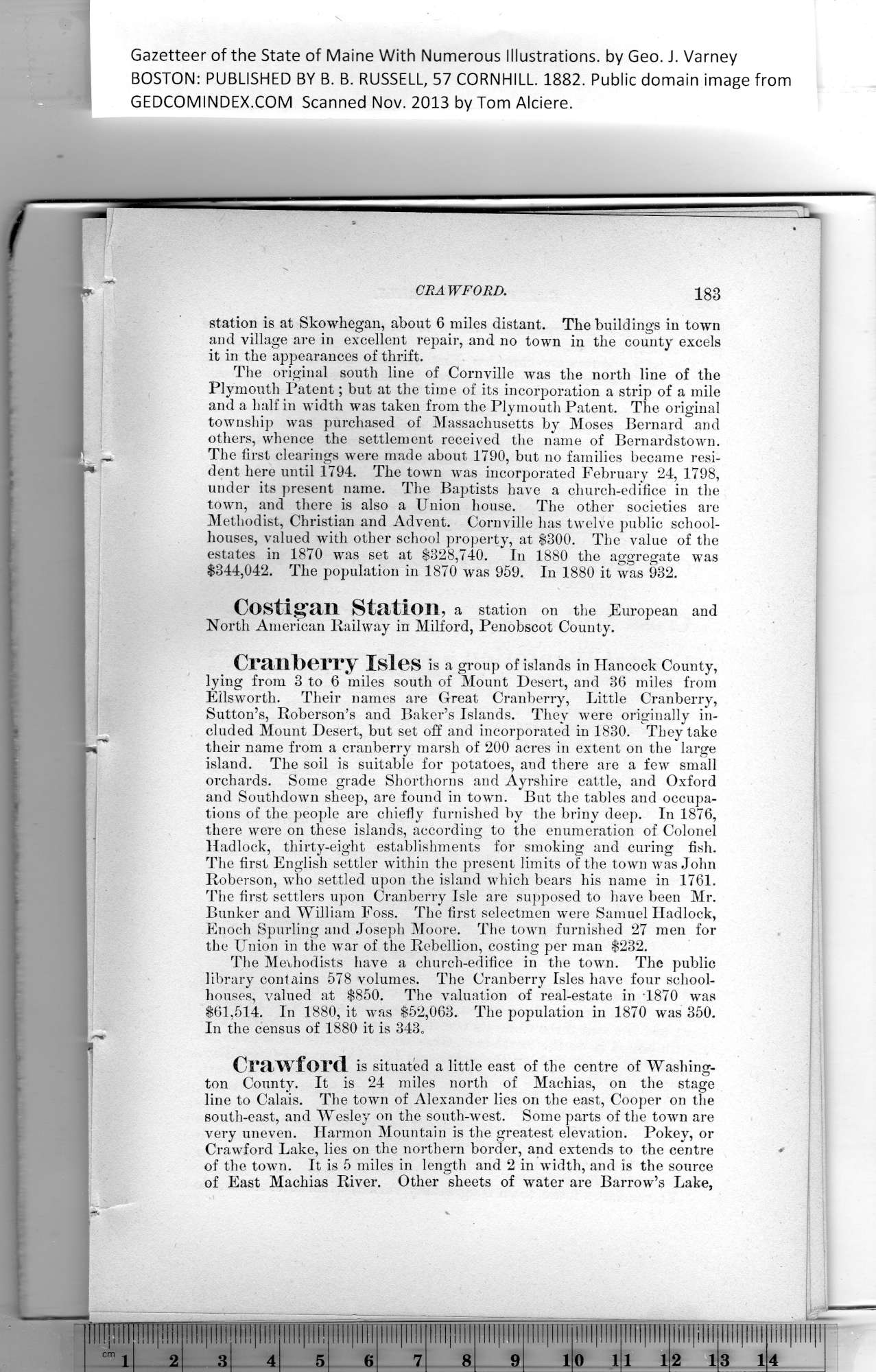|
Gazetteer of the State of Maine With Numerous Illustrations, by Geo. J. Varney
BOSTON: PUBLISHED BY B. B. RUSSELL, 57 CORNHILL. 1882. Public domain image from
CRAWFORD. 183
station is at Skowhegan, about 6 miles distant. The buildings in town
and village are in excellent repair, and no town in the county excels
it in the appearances of thrift.
The original south line of Cornville was the north line of the
Plymouth Patent; but at the time of its incorporation a strip of a mile
and a half in width was taken from the Plymouth Patent. The original
township was purchased of Massachusetts by Moses Bernard and
others, whence the settlement received the name of Bernardstown.
The first clearings were made about 1790, but no families became resi-
dent here until 1794. The town was incorporated February 24, 1798,
under its present name. The Baptists have a church-edifice in the
town, and there is also a Union house. The other societies are
Methodist, Christian and Advent. Cornville has twelve public school-
houses, valued with other school property, at $300. The value of the
estates in 1870 was set at $828,740. In 1880 the aggregate was
$344,042. The population in 1870 was 959. In 1880 it was 932.
Costig'an Station, a station on the European and
North American Railway in Milford, Penobscot County.
Cranberry Isles is a group of islands in Hancock County,
lying from 3 to 6 miles south of Mount Desert, and 36 miles from
Ellsworth. Their names are Great Cranberry, Little Cranberry,
Sutton’s, Roberson’s and Baker’s Islands. They were originally in-
cluded Mount Desert, but set off and incorporated in 1830. They take
their name from a cranberry marsh of 200 acres in extent on the large
island. The soil is suitable for potatoes, aud there are a few small
orchards. Some grade Shorthorns and Ayrshire cattle, and Oxford
and Southdown sheep, are found in town. But the tables and occupa-
tions of the people are chiefly furnished by the briny deep. In 1876,
there were on these islands, according to the enumeration of Colonel
Hadlock, thirty-eight establishments for smoking and curing fish.
The first English settler within the present limits of the town was John
Roberson, who settled upon the island which bears his name in 1761.
The first settlers upon Cranberry Isle are supposed to have been Mr.
Bunker and William Foss. The first selectmen were Samuel Hadlock,
Enoch Spurling and Joseph Moore. The town furnished 27 men for
the Union in the war of the Rebellion, costing per man $232.
The Methodists have a church-edifice in the town. The public
library contains 578 volumes. The Cranberry Isles have four school-
houses, valued at $850. The valuation of real-estate in 4870 was
$61,514. In 1880, it was $52,063. The population in 1870 was 350.
In the census of 1880 it is 343„
Crawford is situated a little east of the centre of Washing-
ton County. It is 24 miles north of Machias, on the stage
line to Calais. The town of Alexander lies on the east, Cooper on the
south-east, and Wesley on the south-west. Some parts of the town are
very uneven. Harmon Mountain is the greatest elevation. Pokey, or
Crawford Lake, lies on the northern border, and extends to the centre *
of the town. It is 5 miles in length and 2 in width, and is the source
of East Machias River. Other sheets of water are Barrow’s Lake,
PREVIOUS PAGE ... NEXT PAGE
This page was written in HTML using a program written in Python 3.2
| 